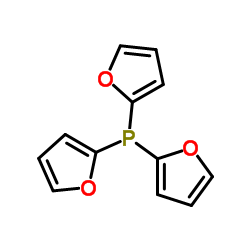Tri(2-furyl)phosphine

Tri(2-furyl)phosphine structure
|
Common Name | Tri(2-furyl)phosphine | ||
|---|---|---|---|---|
| CAS Number | 5518-52-5 | Molecular Weight | 232.172 | |
| Density | N/A | Boiling Point | 286.4±20.0 °C at 760 mmHg | |
| Molecular Formula | C12H9O3P | Melting Point | 59-64 °C(lit.) | |
| MSDS | Chinese USA | Flash Point | 127.0±21.8 °C | |
| Symbol |

GHS07 |
Signal Word | Warning | |
|
The histidine-rich calcium binding protein (HRC) promotes tumor metastasis in hepatocellular carcinoma and is upregulated by SATB1.
Oncotarget 6(9) , 6811-24, (2015) The histidine-rich calcium binding protein (HRC) is a regulator of Ca2+-homeostasis. Herein, we found that HRC was frequently upregulated in human hepatocellular carcinoma (HCC) tissues, and its expression was correlated with tumor size and metastasis. Moreov... |
|
|
Polyamidoamine (PAMAM) dendrimers modified with short oligopeptides for early endosomal escape and enhanced gene delivery.
Int. J. Pharm. 492 , 233-43, (2015) Recently, non-viral vectors have become a popular research topic in the field of gene therapy. In this study, we conjugated short oligopeptides to polyamidoamine-generation 4 (PAMAM G4) to achieve higher transfection efficiency. Previous reports have shown th... |
|
|
Action of anti-M₃muscarinic acetylcholine receptor IgG of primary Sjögren's syndrome on the enzymatic antioxidant system in rat submandibular gland.
J. Oral. Pathol. Med. 44 , 876-83, (2015) We demonstrate that serum immunoglobulin G (IgG) directed against glandular M3 muscarinic acetylcholine receptors (M₃mAChR) and pilocarpine triggers the increment of superoxide dismutase (SOD) and catalase (CAT) and the production of nitric oxide (NO) and pro... |
|
|
Measuring the relative hydrogen-bonding strengths of alcohols in aprotic organic solvents.
ChemPhysChem 16(1) , 160-8, (2015) Voltammetric experiments with 9,10-anthraquinone and 1,4-benzoquinone performed under controlled moisture conditions indicate that the hydrogen-bond strengths of alcohols in aprotic organic solvents can be differentiated by the electrochemical parameter ΔEp (... |
|
|
Leukemia-Associated Mutations in Nucleophosmin Alter Recognition by CRM1: Molecular Basis of Aberrant Transport.
PLoS ONE 10 , e0130610, (2015) Extracellular matrix (ECM) is a rich network of proteins and proteoglycans that has proved to be very useful in tissue regeneration. Porcine ECM has been proposed as a biological scaffold, and urinary bladder matrix (UBM) has demonstrated superior biological ... |
|
|
VAMP8-dependent fusion of recycling endosomes with the plasma membrane facilitates T lymphocyte cytotoxicity.
J. Cell Biol. 210(1) , 135-51, (2015) Cytotoxic T lymphocytes (CTLs) eliminate infected and neoplastic cells through directed release of cytotoxic granule contents. Although multiple SNARE proteins have been implicated in cytotoxic granule exocytosis, the role of vesicular SNARE proteins, i.e., v... |
|
|
Amphiphilic Residues 29-44 of DREAM N-Termini Mediate Calmodulin:DREAM Complex Formation.
Biochemistry 54 , 4391-403, (2015) DREAM (downstream regulatory element antagonist modulator) is a neuronal calcium sensor that has been shown to modulate gene expression as well as to be involved in numerous neuronal processes. In this report, we show that association of calcium-bound calmodu... |
|
|
Calmodulin of the tropical sea cucumber: Gene structure, inducible expression and contribution to nitric oxide production and pathogen clearance during immune response.
Fish Shellfish Immunol. 45 , 231-8, (2015) Calmodulin (CaM) is an essential second messenger protein that transduces calcium signals by binding calcium ions (Ca(2+)) and modulating its interactions with various target proteins. In contrast to vertebrates, where CaM is well established as a cofactor fo... |
|
|
Characterization of the Photophysical, Thermodynamic, and Structural Properties of the Terbium(III)-DREAM Complex.
Biochemistry 55 , 1873-86, (2016) DREAM (also known as K(+) channel interacting protein 3 and calsenilin) is a calcium binding protein and an active modulator of KV4 channels in neuronal cells as well as a novel Ca(2+)-regulated transcriptional modulator. DREAM has also been associated with t... |
|
|
Drug-Drug Interaction Potentials of Tyrosine Kinase Inhibitors via Inhibition of UDP-Glucuronosyltransferases.
Sci. Rep. 5 , 17778, (2015) Tyrosine kinase inhibitors (TKIs) are anticancer drugs that may be co-administered with other drugs. The aims of this study are to investigate the inhibitory effects of TKIs on UDP-glucuronosyltransferase (UGT) activities, and to quantitatively evaluate their... |